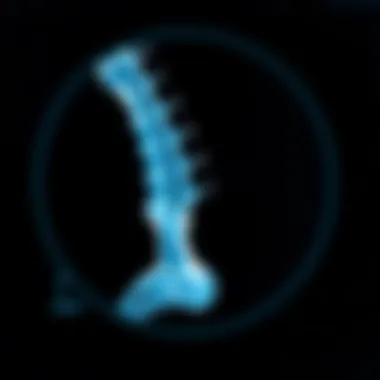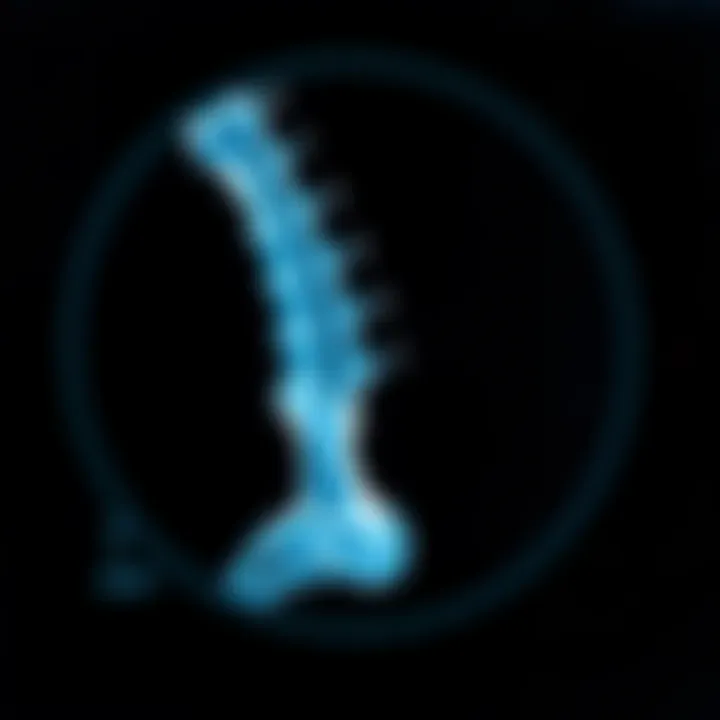Understanding Osteoporosis Levels: A Comprehensive Overview


Intro
Osteoporosis is often whispered about, as if it’s a dirty little secret that many people prefer to ignore. Yet, it's a condition with a significant weight on health systems and a palpable impact on those who suffer from it. Picture it this way: your bones, once sturdy as an oak, morphing into something more akin to dry twigs under the strain of time, neglect, or unfortunate genetic predispositions. The implications are serious, leading to fractures and declines in quality of life for millions. Understanding the levels of osteoporosis isn’t merely a medical endeavor; it’s an essential part of fostering informed choices in health management, sparking conversations about prevention, and acknowledging the paths to treatment.
In this article, we delve into the nitty-gritty details of osteoporosis, aiming to stitch together a tapestry of understanding that goes beyond clinical jargon. From grasping diagnostic criteria to navigating risk factors, we will flesh out the complex nuances that surround this condition. This resource wouldn’t just be a collection of scientific facts; its purpose is to blend practical knowledge with empirical findings, thus empowering individuals, students, researchers, and healthcare professionals alike.
For many, the hurdles of osteoporosis might feel overwhelming, but addressing them with a clear understanding of key concepts can illuminate the path forward. Together, let’s attempt to sort through the variables and trends shaping osteoporosis management today.
Prologue to Osteoporosis
Osteoporosis is not just a medical term tossed around at health seminars; it's a condition that resonates with millions across the globe. This silent disease progressively weakens bones, rendering them fragile and susceptible to fractures. Understanding this condition is crucial for everyone, not just healthcare professionals, as it can drastically affect quality of life and everyday functions.
When engaging with the topic of osteoporosis, we must consider several key elements that underline its significance. For one, the implications of osteoporosis are profound. A fracture, particularly in the hip or spine, could sideline individuals for extended periods. These events are not only physically challenging but can also lead to a cascade of mental and emotional hurdles, culminating in a decreased sense of wellbeing.
Definition of Osteoporosis
Osteoporosis is fundamentally defined as a bone disease characterized by low bone mass and deterioration of bone tissue, which ultimately increases the risk of fractures. To visualize this, think of bones as a honeycomb structure; in osteoporosis, this structure is compromised, becoming less dense and more porous—much like a sponge that has absorbed too much water and begun to lose its rigidity. This condition tends to develop silently, often going unnoticed until a fracture occurs.
Factors contributing to osteoporosis range from hormonal changes to nutritional deficiencies, making it a multifactorial ailment. This complexity underlines the inherent challenge in managing and educating populations about the disease. Unfortunately, many people remain unaware of the often-preventive steps available until it’s too late.
Global Prevalence Rates
Osteoporosis doesn’t discriminate; it affects all demographics, though certain groups are at greater risk. Recent estimates indicate that approximately 200 million individuals worldwide suffer from osteoporosis. It’s not solely a concern for older adults; younger people can also be impacted if they adopt unhealthy and sedentary lifestyles.
Some eye-opening statistics illustrate the matter: 1 in 3 women and 1 in 5 men over the age of 50 will experience osteoporotic fractures. This situation is not confined to one geographic region; osteoporosis is globally prevalent, with varying rates influenced by dietary habits, culture, and healthcare access.
As we delve deeper into osteoporosis levels, it becomes increasingly clear that understanding this condition goes beyond mere statistics. It necessitates engagement with prevention strategies, treatment options, and the need for active health management. A comprehensive grasp of osteoporosis assists individuals in making informed health decisions, ultimately promoting better bone health for future generations.
"Knowledge is power; understanding osteoporosis can empower individuals to take charge of their bone health before it's too late."
To further explore this pressing health concern, domestic and international health organizations (such as NIH and WHO) offer a wealth of information and resources.
Understanding Bone Density and Osteoporosis Levels
Grasping the concepts of bone density and osteoporosis is essential for anyone dealing with bone health, whether you’re a student, research personnel, or a medical professional. This knowledge serves as a building block for understanding how conditions like osteoporosis develop and how they can be managed or prevented. Bone density, in particular, acts as a critical barometer indicating how much bone mineral content we have, which directly links to our overall bone strength and susceptibility to fractures.
In this section, we will delve deeply into the importance of measuring bone mineral density (BMD) and exploring the relationship between BMD and osteoporosis levels. Understanding these dynamics equips various stakeholders—from healthcare providers to patients—with crucial insights that go beyond common knowledge, elevating preventive and corrective actions in bone health management.
Bone Mineral Density: An Overview
Bone mineral density is often regarded as a pivotal measure in evaluating bone health. It offers a concrete number that reflects the mineral content in bone mass, allowing clinicians to determine whether an individual has normal bone density, threatens osteoporosis, or is already diagnosed with the condition. The T-score obtained from BMD measurements can be an eye-opener, often prompting proactive measures if below certain thresholds.
However, it's worth noting that bone density alone doesn’t tell the whole story. Factors such as bone quality and geometry also play vital roles in fracture risk assessment. Hence, while BMD is a critical indicator, it must be contextualized within a broader framework that considers other aspects of bone health, like environmental influences and lifestyle choices.
Measurement Techniques
Effective management and diagnosis hinge on accurate measurement techniques. Various methods exist, but two have stood out, namely Dual-Energy X-ray Absorptiometry and Quantitative Computed Tomography.
Dual-Energy X-ray Absorptiometry (DXA)
Dual-energy X-ray absorptiometry, or DXA, is often seen as the gold standard in BMD measurement. One primary characteristic of DXA is its efficiency in determining bone density with minimal radiation exposure. This method uses two X-ray beams, which vary in energy levels, to measure bone absorption rates within a specified area, usually the hip and spine, which are common fracture sites.
What sets DXA apart is its ability to provide regional assessments while being quick and straightforward, making it an appealing choice for healthcare settings. The convenience it offers for both patients and providers can’t be understated. However, while DXA is highly beneficial, it does come with some limitations, such as its inability to measure bone quality, and potential inconsistencies based on body composition, particularly in overweight individuals.
Quantitative Computed Tomography (QCT)
On the other hand, Quantitative Computed Tomography (QCT) provides a three-dimensional picture of bone density. This technique captures detailed images of bone architecture rather than just density, making it invaluable for understanding how structural changes correlate with fracture risks. A key characteristic of QCT is its ability to assess both trabecular and cortical bone, unlike DXA, which primarily evaluates total BMD.
QCT is considered a more advanced method for those looking to dive deeper into bone analysis, as it allows for a more nuanced evaluation of bone health. Yet, the use of QCT is encumbered by higher costs, longer procedures, and greater radiation exposure. Thus, while it holds its unique advantages, QCT is often reserved for situations where DXA results are inconclusive or when detailed structural analysis is imperative.
In summary, understanding bone density and osteoporosis levels requires precise measurement techniques like DXA and QCT, which can offer distinct insights into bone health. Both methods come with unique benefits and drawbacks, but knowing when to employ each is critical for optimal patient care.
Understanding these principles will promote informed decision-making and potentially lead to improved patient outcomes in bone health management.
Risk Factors Associated with Osteoporosis
Understanding the risk factors associated with osteoporosis is crucial for recognizing how this condition develops and the steps to mitigate its impact. Identifying these factors not only aids in prevention but also allows individuals to make informed decisions about their bone health. The intersection of genetic, lifestyle, and hormonal influences offers a multifaceted view of osteoporosis, enabling healthcare providers, educators, and the general public to grasp the intricacies of this common ailment.
Genetic Predispositions
Genetics play a significant role in the risk of developing osteoporosis. Individuals with a family history of fractures, particularly hip or spine fractures, are more likely to experience similar issues in their own lives. Genes can dictate bone density and quality, affecting how the body absorbs calcium and processes vitamin D. For example, certain variants linked to collagen production might weaken bone structure, leading to higher vulnerability. Although we cannot change our genetic makeup, awareness of family histories can spark proactive measures, such as earlier screenings and tailored preventative strategies tailored to individual risks.
Lifestyle Influences


Lifestyle choices have a profound effect on bone health. They can either bolster the skeletal framework or lead to deterioration, making this topic essential in addressing osteoporosis.
Dietary Considerations
Diet is a cornerstone of bone health. A diet rich in calcium and vitamin D is essential for maintaining robust bone structure. Foods like dairy, leafy greens, and fatty fish should be staples in one’s diet. However, it’s not just about eating calcium-rich foods; it’s crucial to understand how your body absorbs these nutrients. For instance, excessive salt and caffeine can hinder calcium absorption, which poses a challenge, especially for those who consume these regularly. Therefore, strategizing meals to balance benefits while avoiding drawbacks is pivotal for promoting long-term bone health.
Physical Activity Levels
Physical activity, particularly weight-bearing exercises, plays a vital role in bone strength and density. Engaging in activities such as walking, running, or dancing helps bones retain their mineral content and improves muscle strength, thereby reducing falls and fractures. One particularly effective aspect is resistance training, which directly stimulates bone growth. However, activity levels need to be matched to an individual's capabilities. Overexertion or a sudden increase in activity can be counterproductive or even lead to injuries.
Tobacco and Alcohol Use
Smoking tobacco and excessive alcohol consumption negatively impacts bone health dramatically. Tobacco use has been linked with decreased bone density and increased fracture risk. It disrupts the balance of hormones responsible for bone health, while also affecting calcium absorption. On the other hand, high alcohol consumption can interfere with the body’s ability to absorb calcium effectively and can also inhibit bone-forming cells. Reducing these substances can lead to significant improvements in overall bone health, which positions individuals favorably against osteoporosis.
Hormonal Factors
Hormones are pivotal in maintaining bone density, and changes in hormonal levels can raise the risk of osteoporosis. For example, postmenopausal women experience a significant reduction in estrogen, a key hormone that protects against bone loss. Similarly, conditions like hyperthyroidism can increase bone resorption, accelerating the thinning process. Therefore, monitoring hormonal health could provide insights into preventing osteoporosis.
"Understanding lifestyle choices, alongside genetic predispositions, can offer a powerful combination in the fight against osteoporosis."
Comprehending these risk factors is more than just listing them; it equips individuals with knowledge on how to navigate their health. By making informed lifestyle choices and being aware of their genetic backgrounds, individuals can take steps toward healthier bones and a lower risk of osteoporosis.
Diagnostic Criteria for Osteoporosis
The assessment of osteoporosis relies fundamentally on diagnostic criteria, creating a pivotal foundation for preventing, identifying, and managing this condition effectively. Diagnosing osteoporosis accurately goes beyond mere suspicion; it utilizes specific guidelines and systems that categorize individuals based on bone density levels. This is crucial not just for clinicians but also for patients who are eager to understand their bone health status. By identifying those at risk, it can pave the way for timely interventions, reducing the likelihood of fractures associated with this disease.
WHO Classification System
The World Health Organization (WHO) has established a classification system that serves as a benchmark for diagnosing osteoporosis. This system primarily revolves around the measurement of bone mineral density (BMD). The WHO categorizes individuals into several categories based on their T-scores obtained from bone density scans.
- Normal Bone Density: T-score of -1.0 or above
- Low Bone Mass (Osteopenia): T-score between -1.0 and -2.5
- Osteoporosis: T-score of -2.5 or lower
- Severe Osteoporosis: T-score of -2.5 or lower with one or more fragility fractures
By using this standard, healthcare providers ensure that they are aligned internationally in diagnosing and treating osteoporosis, which is increasingly vital in our globalized world. It provides a clear framework that helps in recognizing those who may need closer observation or intervention. Importantly, this classification also encourages a proactive approach to managing bone health as part of a patient’s overall well-being.
Interpretation of T-scores
Understanding T-scores is imperative for both patients and healthcare providers, as it translates complex measurements into actionable insights. T-scores derive from comparing an individual's BMD with that of a young adult reference population, providing a snapshot of the relative density of one’s bones. The lower the T-score, the greater the risk of osteoporosis and fractuals.
- A T-score of -2.5 or lower signals osteoporosis, suggesting a significant reduction in bone density, which can sharply increase fracture risk.
- A T-score between -1.0 and -2.5 denotes osteopenia, indicating that while the bone density isn’t low enough to diagnose osteoporosis, it requires monitoring and potential lifestyle adjustments.
Clinical Implications of Osteoporosis Levels
Understanding the clinical implications of osteoporosis levels is paramount for anyone delving into bone health. This section dives into the significance of recognizing and addressing osteoporosis, not just for individual patients but also for the broader healthcare system. High prevalence rates of osteoporosis bring a range of challenges that must be navigated carefully.
Osteoporosis increases the risk of fractures, particularly in vulnerable populations like older adults. Such fractures can significantly impact quality of life. They often lead to extended hospital stays, surgical interventions, and substantial rehabilitation efforts. Besides the immediate physical ramifications, fractured bones can also usher in a cascade of emotional distress, immobilization, and a decline in overall autonomy.
Fracture Risk Assessment
When it comes to osteoporosis, understanding the fracture risk is essential. Assessment of fracture risk is not merely about identifying who might break a bone; it focuses on predicting and preventing potential fractures before they occur. The key tools utilized in fracture risk assessment include:
- Clinical Risk Factors: These encompass age, gender, previous fracture history, family history of osteoporosis, and lifestyle factors such as tobacco use or excessive alcohol consumption.
- Bone Density Measurements: The T-score, derived from bone mineral density tests, plays a crucial role in assessing fracture risk. A lower T-score indicates decreased bone density, resulting in heightened risk.
- Fracture Risk Algorithms: Tools like the FRAX tool can help healthcare providers assess risk and direct appropriate interventions based on calculated probabilities.
Implementing a meticulous fracture risk assessment can significantly alter a patient’s management plan. Not only does it guide treatment strategies, but it also empowers patients with knowledge about their health, fostering engagement in preventive measures and adherence to treatments. Fracture prevention in osteoporosis goes hand in hand with comprehensive care approaches that encompass both lifestyle modifications and pharmacological therapies.
Health Care Management Strategies
Managing osteoporosis effectively requires a multifaceted approach. Key strategies include:
- Personalized Treatment Plans: Every patient is different. Tailoring treatment plans based on individual risk factors, preferences, and comorbid conditions is crucial.
- Multidisciplinary Collaboration: Involving various healthcare professionals—from primary care physicians to specialists in endocrinology and nutrition—creates a holistic approach to management.
- Patient Education: Informing patients about their condition, along with discussion of treatment options and lifestyle modifications, fosters a sense of ownership over their health. Educated patients are more likely to comply with recommended interventions.
- Regular Monitoring: Periodic follow-ups and ongoing assessment of bone density and fracture risk help catch any potential deterioration in a patient’s condition before it escalates. Adjustments to treatment plans can then be made as necessary.
Prevention Strategies for Osteoporosis
Preventing osteoporosis is a matter of significant importance, considering that this condition leads to a higher risk of fractures, which may severely impact an individual's quality of life. The essence of preventive measures lies in their ability to bolster bone health before osteoporosis takes root, addressing the potential risks at their core. By understanding and implementing effective strategies, individuals can safeguard their bone density and overall health throughout their lives.
Nutritional Approaches
Calcium and Vitamin Intake
Calcium and vitamin D are pivotal elements in maintaining strong bones. The link between calcium intake and bone density is particularly pronounced; adults generally require about 1,000 to 1,200 mg of calcium daily, depending on age and gender. Vitamin D plays a crucial role in assisting the body to absorb calcium, making it equally important.
Daily sunlight exposure can help with vitamin D synthesis, but supplementation may become crucial, especially in regions with limited sunlight. Many experts recommend fortified foods like cereals, milk, and even orange juice as excellent sources.
The unique feature of calcium is its capacity to strengthen bone structure, while vitamin D facilitates its absorption—combined, these create a powerful defense against bone density loss. However, individuals should be cautious not to exceed recommended intakes, as overconsumption can lead to health issues such as kidney stones or cardiovascular concerns.
Exercise Recommendations


Weight-Bearing Activities
Weight-bearing exercises are a cornerstone of osteoporosis prevention. These activities force the body to work against gravity, which helps in strengthening bones and enhancing bone density. Simple weight-bearing exercises include walking, jogging, jumping, or even dancing. The keystone here is consistency—regular engagement is crucial.
A key characteristic of weight-bearing activities is their accessibility; most individuals can incorporate some form of these exercises into their routines without specialized equipment. However, one should start gradually, especially if new to exercise, to avoid injury.
The advantage of this type of exercise is its dual benefit—not only does it support bone health, but it also improves overall physical fitness and resilience.
Balance Training
Balance training is another essential component of osteoporosis prevention. This focus helps individuals, especially older adults, enhance stability and coordination, reducing the risk of falls—a significant cause of fractures. Common balance exercises include tai chi, standing on one foot, or using balance boards.
The main characteristic of balance training is that it focuses not just on muscle strength but on the body's ability to maintain posture and equilibrium. Such practices can be found in community classes or even through online platforms that promote physical health.
The unique feature here lies in its preventive potential; by improving balance, the risk of falls and subsequent fractures decreases significantly. However, balance training may require patience, as improvements can take time to manifest.
Incorporating both weight-bearing and balance training into a regular routine can provide comprehensive benefits, enhancing not just bone strength but also overall well-being.
Treatment Options for Osteoporosis
When it comes to managing osteoporosis, understanding treatment options is essential. Effective treatment can not only help to maintain bone density but also reduce the risk of fractures. The treatment landscape is diverse, covering everything from medications to lifestyle changes. Knowing the available options helps individuals make informed choices in discussions with their healthcare providers. This section delves into both pharmacological and non-pharmacological treatments that play a vital role in osteoporosis management.
Pharmacological Treatments
Pharmacological treatments for osteoporosis primarily aim to improve bone mineral density and lower fracture risk. Several medications are commonly prescribed, each with distinct mechanisms and benefits.
Biphosphonates
Biphosphonates are one of the most frequently prescribed classes of medications for osteoporosis. They work by slowing down bone resorption, meaning they help to counteract the natural process that leads to bone loss. A prominent characteristic of biphosphonates is their effectiveness in reducing the likelihood of spinal and hip fractures.
A unique feature of biphosphonates is their long-term efficacy, as they remain in the bones and continue to exert their benefits for years even after discontinuation. However, patients must also consider some downsides, including potential side effects such as gastrointestinal issues. Despite this, the effectiveness of biphosphonates makes them a popular choice for many.
Denosumab
Denosumab is another important medication that has gained traction in the past decade. Unlike biphosphonates, denosumab works as a monoclonal antibody that inhibits the activity of osteoclasts, cells that break down bone. This key characteristic ensures that bone formation can outpace resorption, thereby increasing overall bone density.
One of the appeals of denosumab lies in its subcutaneous administration, which may be more convenient for patients. However, it requires regular injections and, like all medications, comes with its own set of risks, such as infections. For those looking to improve their bone health diligently, denosumab can be an effective choice under the right medical guidance.
Hormonal Therapies
Hormonal therapies, including estrogen therapy, can be particularly beneficial for postmenopausal women suffering from osteoporosis. The primary role of these treatments is to replenish hormones that decline after menopause, thereby helping to maintain stronger bones. A noteworthy strength of hormonal therapies is their dual benefit; they not only enhance bone density but can also alleviate menopausal symptoms.
Nonetheless, this treatment is not without risks, including an increased likelihood of blood clots and certain cancers. Thus, healthcare providers typically weigh the benefits against potential hazards meticulously.
Non-Pharmacological Interventions
Non-pharmacological interventions are critical companions to any pharmacological treatment for osteoporosis. While medications provide essential support in building strength, lifestyle choices—like nutrition and physical activity—are equally influential.
- Nutrition: A diet rich in calcium and vitamin D is foundational. Foods such as dairy products, leafy greens, and fish can strengthen bone health.
- Exercise: Weight-bearing and resistance exercises play a pivotal role in maintaining bone density. Activities like walking, dancing, and weightlifting are instrumental in stimulating bone formation.
- Lifestyle Adjustments: Reducing tobacco use and limiting alcohol consumption can significantly decrease the risk of developing osteoporosis.
"Choosing the right combination of treatments can be as important as the treatments themselves."
Through a multifaceted approach combining pharmacological treatments with non-pharmaceutical interventions, individuals can optimally manage their bone health. Education and awareness about these various options can empower patients, fostering a proactive attitude towards osteoporosis treatment.
Current Research on Osteoporosis Levels
Research on osteoporosis levels has become more crucial than ever as it directly impacts the way we approach bone health. With a deeper understanding of this condition, healthcare professionals can better tailor prevention and treatment strategies to individual needs. The landscape of osteoporosis management continuously evolves, influenced by the latest studies and clinical findings. Recent advances offer fresh perspectives on both emerging therapies and longitudinal studies, shedding light on the multifaceted nature of osteoporosis.
Emerging Therapies and Technologies
The development of new therapies and technologies represents a pivotal point in the advancement of osteoporosis treatment. The field has seen significant innovation, leading to options that extend beyond traditional approaches.
For instance, several studies are focusing on monoclonal antibodies such as Romosozumab, which can promote bone formation while inhibiting bone resorption. This dual action is great news for patients who have not had much success with existing treatments.
Moreover, telemedicine is reshaping osteoporosis management. Remote consultations and monitoring allow healthcare providers to reach patients in more areas, providing them with necessary support without needing to travel. This is particularly beneficial for elderly individuals who often face mobility issues.
The significance of ongoing research cannot be understated. Expanding avenues for treatment can result in more effective interventions and improved patient outcomes.
"Research is the key that opens the door to advanced treatments in osteoporosis management, ultimately leading to healthier bones across demographics."
Longitudinal Studies and Findings
Longitudinal studies form a cornerstone of understanding osteoporosis over time. These studies track the same individuals over various intervals, providing insights into how bone health can change with age, lifestyle modifications, and intervention strategies.


One significant finding pertains to the correlation between lifestyle changes and bone density improvements. Long-term studies have shown that consistent engagement in weight-bearing exercises can mitigate bone loss in older adults. Furthermore, nutritional assessments often reveal how deficiencies in calcium and Vitamin D can lead to complications in bone health, highlighting the necessity for routine dietary evaluations.
These findings emphasize the importance of continuous monitoring and encourage proactive measures amongst those at risk. Health providers can leverage this data to guide individualized treatment plans that are more likely to succeed based on real-world evidence.
Role of Healthcare Providers in Osteoporosis Management
Effective management of osteoporosis hinges heavily on the active involvement of healthcare providers. These professionals play a crucial role in guiding patients through their diagnosis, treatment, and long-term management strategies. Understanding how healthcare providers contribute not only empowers patients but also helps establish a supportive care system that can significantly enhance treatment outcomes.
Patient Education and Counseling
Proper education is paramount in osteoporosis management. Healthcare providers must ensure that patients comprehend the nature of their condition. Many individuals may not fully grasp how osteoporosis affects their overall health, which can lead to poor adherence to treatment plans. By taking the time to explain the implications of low bone density, providers can help patients recognize the importance of prevention and management strategies.
- Emphasizing the causes of osteoporosis, including age, gender, and lifestyle choices, can motivate patients to take proactive measures.
- Regular discussions about the effects of medication and the importance of calcium and vitamin D supplementation can reinforce patients’ commitment to their treatment plans.
- In addition, counseling on risk factors helps patients identify modifiable behaviors, such as diet and physical activity, that can directly impact their bone health.
Moreover, healthcare providers can facilitate support groups or connect patients with resources such as educational materials or websites. The personal touch that comes from one-on-one counseling enhances the trust between patients and their providers, which is essential for ongoing care.
"When patients feel informed and supported, it can make all the difference in managing their osteoporosis effectively."
Collaborative Care Approaches
Collaborative care approaches are vital in creating a comprehensive framework for managing osteoporosis. A multidisciplinary team typically involves primary care physicians, endocrinologists, dietitians, and physical therapists. Each member of this team contributes unique perspectives and solutions towards patient care.
- Primary care physicians are often the first point of contact for patients, managing overall health and referring them to specialists when necessary.
- Endocrinologists focus on hormonal aspects that affect bone density and can provide specialized treatment options tailored to individual needs.
- Dietitians help patients develop nutritional plans that include sufficient calcium and vitamin D, critical components for maintaining bone strength.
- Physical therapists design exercise programs aimed at enhancing strength, balance, and coordination, reducing the risk of falls and fractures.
This collaborative framework not only ensures that patients receive well-rounded care, but also encourages open communication among providers, which can lead to better patient outcomes. When healthcare providers work together, they can create personalized care plans that address each patient's unique needs, ultimately leading to more effective management of osteoporosis.
Demographic Variations in Osteoporosis Levels
Understanding demographic variations in osteoporosis levels is critical for several reasons. Not only do these variations help inform treatment and prevention strategies, but they also underscore the importance of targeted research and education efforts. Recognizing how factors such as gender, age, and race impact osteoporosis prevalence can lead to better health outcomes for affected individuals.
Gender Differences
One of the most significant demographic factors in osteoporosis is gender. Statistically, women are more likely to experience osteoporosis than men. After menopause, women face a sharp decline in estrogen levels, a hormone that plays a vital role in maintaining bone density. This hormonal change significantly contributes to the increased risk of developing osteoporosis in women as they age.
Moreover, it’s not just during menopause that gender differences manifest. Men have a higher peak bone mass, which can provide some protective benefit against osteoporosis later in life. However, once they do develop osteoporosis, their fractures may be more severe compared to women.
Interestingly, some studies have noted that men tend to be diagnosed with osteoporosis later than women, often because of a lack of awareness about their risk factors. This underdiagnosis can lead to more severe outcomes and complications for men when the disease is finally diagnosed. Considering these gender differences helps in tailoring prevention and treatment protocols effectively.
Age-Related Implications
Age is another crucial factor that directly influences osteoporosis levels. As individuals age, bone density naturally decreases. For many, this gradual loss of bone mass begins around the age of 30 and accelerates post-menopause for women. The aging process is marked not only by the loss of bone density but also by changes in the body's ability to absorb calcium, which is essential for maintaining healthy bone vital signs.
In older adults, the risk of falls increases, further compounding the risk of fracture for those with osteoporosis. It’s vital to recognize that these age-related changes can lead to more significant health complications, including prolonged hospital stays, loss of independence, and even an increased risk of mortality following a fracture.
Addressing the implications of age on osteoporosis involves more than just focusing on prevention. It calls for comprehensive strategies that include regular screening, weight-bearing exercises to enhance strength, and adequate dietary intake of calcium and vitamin D.
The interplay between age and bone density signifies a critical area for ongoing research and healthcare focus as populations continue to age.
Understanding the interplay between gender, age, and osteoporosis can help policymakers, healthcare providers, and educators tailor interventions that resonate across various demographic groups. Developing age-appropriate and gender-specific strategies is paramount in combating the growing epidemic of osteoporosis effectively.
The End and Future Directions
The conclusion of this article emphasizes the complex yet vital nature of osteoporosis levels, focusing on informing about diagnostic criteria, risk factors, and proper management strategies. Understanding osteoporosis is paramount, as it affects an extensive demographic across various age groups, and addressing this condition can lead to substantial improvements in public health. The future directions suggested herein highlight critical areas for ongoing research and the potential for advances that could redefine our approach to managing osteoporosis.
Key elements discussed include:
- Understanding and monitoring bone density: It is essential to develop more refined measurement techniques and reliable indicators of bone health.
- Individualized treatment approaches: With advancements in personalized medicine, treatments can become more tailored to the individual's specific needs and responses.
- Enhancing public awareness: Education on prevention strategies is a crucial component in combating osteoporosis, emphasizing the importance of calcium and vitamin D, alongside regular exercise.
Future considerations also involve better integration of emerging therapies into existing care practices. This includes evaluating novel medications that promote bone formation and understanding the genetic factors that underlie osteoporosis risk.
Ultimately, progressing in this field not only involves exploring new treatments but also comprehensively addressing the economic and social implications of osteoporosis. Investing in research and enhancing the collaboration between healthcare providers will pave the way for innovative practices that can ultimately reduce the burden imposed by this silent epidemic on individuals and societies alike.
Summary of Key Findings
The key findings of this article highlight several significant aspects of osteoporosis:
- Osteoporosis is predominantly underdiagnosed and undertreated, especially in men and younger populations.
- Risk factors vary widely, including lifestyle choices such as diet and physical activity, but genetic predispositions also have a notable impact.
- Utilization of advanced diagnostic techniques, like DXA scans, is essential for accurate assessment of bone density.
- Research is revealing novel insights into pharmacological and non-pharmacological interventions that can significantly mitigate osteoporosis risks.
The synthesis of these findings underscores a pronounced need for heightened awareness across all demographics, advocating for proactive measures and prevention strategies tailored to individual risk levels.
Advancements in Osteoporosis Research
Recent advancements in osteoporosis research are paving the way for significant shifts in how we comprehend and manage bone health. Highlights include:
- Emerging Biologics: New therapies like monoclonal antibodies are becoming available, offering alternatives to traditional bisphosphonates, particularly for those who may not tolerate the latter.
- Genetic Studies: The exploration of genes associated with bone strength provides a clearer understanding of predispositions to osteoporosis.
- Digital Health Technologies: With the rise of wearable devices, continuous monitoring of physical activity and dietary habits is becoming increasingly feasible, promoting better management of bone health.
- Nutrition Science: Ongoing studies are examining the relationship between gut health and bone density, potentially highlighting new dietary recommendations for osteoporosis prevention.
The endeavor to correlate molecular aspects of bone biology with practical treatment solutions is an exciting frontier. Collaborative efforts among researchers, healthcare professionals, and patients are crucial for translating these findings into effective clinical practices.
"By bridging the gap between innovative research and practical application, we open doors to better, smarter osteoporosis management strategies for future generations."
For more detailed insights into osteoporosis and related ongoing research, resources such as the National Institutes of Health, Wikipedia's page on Osteoporosis, and Brittanica could serve as valuable references.







